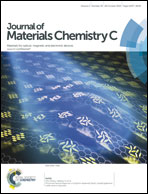New azobenzene-based chiral-photochromic substances with thermally stable Z-isomers and their use for the induction of a cholesteric mesophase with a phototunable helix pitch†
Abstract
Novel photosensitive azobenzene-containing substances with sorbitol- and lactate-based chiral fragments were synthesized to serve as chiral-photochromic dopants in cholesteric mixtures. Owing to the presence of chlorine or methyl lateral substituents in the azobenzene fragment of the dopants, the photoinduced Z-form of their molecules is highly stable. The photooptical properties of the prepared cholesteric mixtures were studied and it was shown that UV-irradiation of the planarly-oriented films results in a shift of the selective light reflection wavelength to a long-wavelength spectral region due to E–Z isomerization of the azobenzene moieties. This process is thermally and photooptically reversible and the rate of blue-light-induced helix twisting is comparable with the rate of the untwisting process, whereas the thermal relaxation completes only after ca. 40 days at room temperature (for a chlorine-substituted chiral-photochromic dopant). It was found that this value is almost two orders of magnitude less in comparison with the non-substituted chiral-photochromic dopant also studied in this work. The obtained results demonstrate the promising properties of the synthesized compounds for creation of novel photoswitchable cholesteric materials.


 Please wait while we load your content...
Please wait while we load your content...